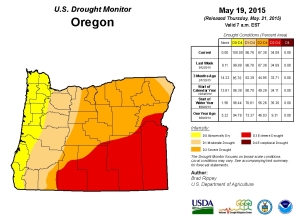Farmers in nearly half of Oregon’s counties can apply for $2.5 million in USDA drought relief funding through June 26. The money is available to encourage conservation practices that reduce water consumption, mitigate erosion, and improve water infiltration and retention.
Growers within counties declared by Oregon Gov. Kate Brown to be in a drought are eligible. The USDA’s Natural Resources Conservation Service instructs growers from Baker, Crook, Deschutes, Grant, Harney, Jackson, Josephine, Klamath, Lake, Lane, Malheur, Morrow, Umatilla, Wasco, and Wheeler counties to contact water basin representatives for applications and submission guidelines.
Go to the USDA basin directory for a list of contacts.
For more drought relief updates read, “Water relief workshops, tips, and USDA aid available for growers.”
Read the full release below
Portland, Ore. (May 26, 2015) — The USDA Natural Resources Conservation Service (NRCS) in Oregon announces up to $2.5 million in funding available to farmers, ranchers and forest landowners to mitigate the effects of drought in counties that have secured drought declarations from the Governor’s Office.
At this time those counties are: Baker, Crook, Deschutes, Grant, Harney, Jackson, Josephine, Klamath, Lake, Lane, Malheur, Morrow, Umatilla, Wasco and Wheeler. If additional counties receive a drought declaration they will also have the opportunity to apply for this funding.
Landowners in these counties should submit applications to their local USDA Service Center by June 26 to be considered for funding.
“This funding will help Oregonians in the most drought-stricken areas of the state to mitigate the impacts of drought on cropland, rangeland and forestland,” said Ron Alvarado, state conservationist. “This funding amplifies the work NRCS continues to do every day to support water conservation, soil health and productivity on Oregon’s working agricultural lands and forest lands.”
NRCS will give higher priority to applications in counties with the highest drought status according to the USDA Drought Monitor, however, producers in all counties declared by the Governor will be eligible to apply for funding. The USDA drought monitor is updated weekly every Thursday and classifies counties under five drought categories: D0 – Abnormally Dry; D1 – Moderate Drought; D2 – Severe Drought; D3 – Extreme Drought; and D4 – Exceptional Drought. All of Eastern Oregon is in a D2 or D3 drought status.
In Oregon, NRCS will focus the funding on cropland, rangeland and forestry conservation practices. For cropland practices, NRCS will assist producers with planting and managing cover crops and implementing emergency soil erosion measures. These practices will help farmers protect the soil from erosion, promote more organic matter in the soil, and aid in better water infiltration.
For rangeland practices, NRCS will assist ranchers in developing grazing management plans and installing emergency livestock watering facilities and multi-purpose water impoundments. These practices help reduce pressure on stressed vegetation, allow the soil to retain more moisture, and deliver emergency water supplies to livestock.
For forestry practices, NRCS will help landowners with wildfire prevention measures, such as creating fuel breaks, multi-purpose water impoundments and other fuel reduction activities. These actions reduce excess vegetation in a forest so that wildfire has less fuel to spread higher into the canopy, where it causes the most damage. NRCS is partnering with the Oregon Department of Forestry to focus the funding on areas with a higher risk for catastrophic forest fire (see map showing wildfire risk in Oregon).
The funding will be made available to eligible landowners through the NRCS’ Environmental Quality Incentives Program (EQIP). This is a popular financial assistance program in the Farm Bill that allows NRCS to work directly with private landowners to implement conservation practices and reimburse landowners for a portion of the expense. Read more about EQIP eligibility, selection and payments on the Oregon EQIP webpage.
Applications will be ranked and prioritized for funding based on the drought level, resource concern, conservation benefit, and if applicable, the wildfire risk factor.
Landowners should submit applications by contacting their local USDA Service Center. A list of offices and contact information is available on the NRCS Oregon “Contact Us” webpage.
Oregon’s drought investment is part of a larger $21 million investment by NRCS nationwide, focused on the most severely drought-stricken areas in eight states: Oregon, California, Idaho, Nevada, Utah, Oklahoma, Kansas and Texas. Oregon received $1.5 million of that nationwide investment. NRCS Oregon is making additional state funding available to assist producers during drought, bringing Oregon’s total available drought dollars to $2.5 million.
NRCS is also leveraging partner investments through the new Regional Conservation Partnership Program (RCPP) to put further resources toward projects that foster water conservation and resilience. In the first round of RCPP funding last year, NRCS funded six projects in Oregon — two of those projects specifically address water conservation: 1) the White River Irrigation Efficiency and Stream Flow Restoration Project in Wasco County; and 2) the North Slope Ochoco Holistic Restoration Project in Wheeler County.
NRCS is also focused on reducing the threat of wildfire throughout Oregon’s forests, especially during drought conditions when wildfire becomes more prominent. NRCS is currently working with Oregon landowners on two large-scale projects as part of the Joint Chief’s Landscape Restoration Partnership. This is a partnership between two USDA agencies — NRCS and the Forest Service — to reduce wildfire threats and improve the health and resilience of forest ecosystems on public and private lands across the nation. Oregon’s two projects under this partnership are the East Face of the Elkhorn Mountains Project (Baker and Union counties) and the Ashland Forest All-Lands Restoration Project (Jackson County).







Leave A Comment